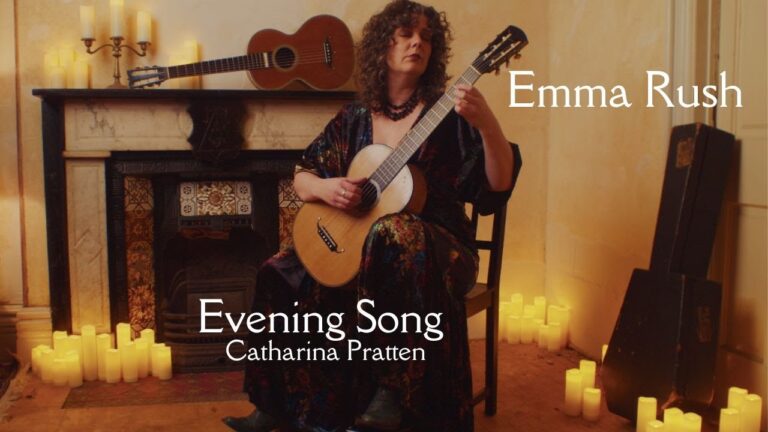A big thank you to Marcus Dominelli for this great interview. Marcus is always willing to sit down and have a talk with me over some coffee and answer my many guitar questions. He’s a friendly guy and always very interested in what players have to say. For more info, articles, and FAQ’s visit his website. Also see Marcus’s other guest post: Bracing Styles for Classical Guitars.
Interview via email on June 21, 2012 (previously published on Classical Guitar Canada).
Bradford Werner: How do luthiers pick a good top and back/side wood?
Marcus Dominelli: The top is the most important wood on the guitar, so I’m very picky about what I’ll use in this regard. But it should be stiff, lightweight, and resonant. The grain count is not super important for me, but I tend to like the sound of spruce with slightly wider grain, maybe 15 to 18 grains per inch. Cedar generally has tighter growth rings, maybe 25 or 30 gpi.
Aesthetics are important in a soundboard too. I don’t really care for the look of bear claw in the top, but strong medulary rays are nice. They tend to be present in perfectly quartersawn wood, and appear as shiny cross grain ribbon lines. I prefer cedar with some colour streaking in it, and tend to avoid the bland looking even toned stuff you find on most factory guitars.
For back and sides, I go for nice colour and straight grain. Density is not too important for me when it comes to the back and sides because I can always adjust the thickness and/or bracing to get the back resonance I’m after.
Bradford: I sometimes see people gazing into the grain of the wood. What can students and players tell by looking at the grain?
Marcus: That’s an interesting question. I suppose it means different things to different people depending on what they know and appreciate about wood.
I would recommend that players not concern themselves too much about the woods, and what they might mean. For example, don’t choose one guitar over another just because you read somewhere that the soundboard should have at least 25 grains per inch, or one type of rosewood over another.
One thing I really like about classical guitar players is that they seem very much tuned into the sound they’re after. Typically, at a convention like GFA, or another guitar festival, someone will pick up a guitar, play it for a few minutes and really get absorbed by the sound. Then afterwards will say, “That’s a really nice sounding guitar. What are the woods used?”
Amateur players and hobbyists will often want to know more about the woods and construction methods than the sound, which is a bit silly, since it is a musical instrument. Wood is a means to an end, not an end in itself.
Bradford: How do flamenco guitars compare to classical guitars in terms of design?
Marcus: There has been so much misinformation written on this subject. It would be nice if we could find a clean and easy way to draw a line between the two types of guitars, but it cannot easily be done. Generally speaking, and I mean very generally, flamenco guitars tend to be more lightly constructed, at least in an overall sense – top, back and sides, and neck. Although classical guitars tend to be more robustly made, this too is only a generalization. For example a Smallman style lattice guitar has an extremely light soundboard, yet the other parts of the guitar are rigid and heavy, to increase sustain and power.
With the flamenco guitar too much sustain is to be avoided, and an overall lightness of construction tends to reduce sustain, helping give the flamenco a bright percussive sound, almost like a drum. The sound is bright, percussive, and woody.
Flamenco guitars usually have a lower action than classicals, and the strings are closer to the soundboard to facilitate the golpe, so the flamenco guitar will need a tap plate as well. Up until about 1950 there was very little difference in terms of design between classical and flamenco guitars, and many luthiers made little or no distinction between the two. But as the classical guitar became more of a concert instrument, it slowly morphed into an instrument with qualities better suited to the concert hall. Projection, power, sustain, and clarity were the needed qualities.
Although a common misconception, the flamenco and classical guitars cannot be differentiated solely in terms of the woods used. While it’s true that a guitar with spanish cypress for back and sides is more likely to be a flamenco guitar, many luthiers make classical guitars with this wood too. In fact, Jose Romanillos, a famous Spanish luthier, said his favourite back and side wood for a classical guitar was cypress, not rosewood. Conversely, many flamenco players are using flamenco guitars with rosewood back and sides.
Bradford: The body of some guitars are thin, while others are thick. What happens to the sound as the size of the resonating body increases?
Marcus: That’s a good question. If you make the body too thick, the bass response is more likely to overpower the trebels. The guitar starts to sound a bit muffled or bass heavy. A deeper body can help the bass response, but it gets harder for the luthier to create strong trebles. Strong trebles can be had with a deeper body of course, but I’ve found that guitars with a thinner body (about 9cm thick at the lower bout) tend to be better balanced and have better clarity. Unfortunately, concert players generally don’t like thin looking guitars. Maybe they equate the smaller size box with a smaller sound, I’m not sure why but there seems to be a prejudice against small concert guitars.
I started making my guitar bodies a bit deeper about 5 years ago because I realized that was what most players wanted. I had to resort to other design changes to try and keep the treble response where I wanted it.
Bradford: What does scale or string length do to the sound?
Marcus: I’ve found that scale length does not really alter the sound much, at least not with my own guitars, in the context of say 640, 650, or 660 scale lengths. If you go much shorter, for example to a 610, 620, or 630, you’re going to get some changes, but usually the size of the guitar body has been scaled down as well, so we’re now introducing other factors that affect the sound beyond just scale length.
A longer scale length means a longer, heavier string. More tension will be required to bring this heavier string up to the same pitch as a lighter string. The stiffer tension will be felt by the player. I think this tactile change is a bigger difference than any tonal one. Conversely, a shorter scale will require less tension to reach the same pitch, and the string will feel more slack to the fingers.
As a general rule, a 640 scale guitar strung with hard tension D’addarios will feel similar to a 650 scale strung with medium tensions.
But as far as sound goes, the overall character of the woods, bracing, and other design elements, are far more important to creating the desired tone. Don’t let anyone tell you that a 640 scale will have dramatically less power or bass response than a 650 or a 660 scale length.
Bradford: Guitars change over time, in particular, as they get played. What is this all about? Is it the vibrations in the wood?
Marcus: Without trying to get scientific about it, yes wood changes as it ages. Resins in the wood crystalize and it takes on a darker tone as it is exposed to oxygen and ultraviolet light. Spruce in particular seems to benefit more from the aging process than cedar does. Wood aging on a shelf will not necessarily make a better guitar, although many luthiers make claims that really old wood will give a superior sound. I have not found this to be true. Some of my nicest sounding guitars were made with relatively fresh wood.
Wood, in the form of a completed guitar, getting played, is what really improves its sound.
Bradford: I’ve noticed that certain players seem to “develop” guitars in different ways. Is there truth behind this or is it just psychological games in my ears.
Marcus: It’s absolutely true. How a particular guitar develops is hugely affected by the skill of the player, and how much time he/she puts in on the guitar. A strong player can open up and improve a guitar in ways that a casual player simply cannot.
Why were Stradivari’s violins so good? Sure they were very well made; he was a master craftsman, possibly the best luthier ever, and his violins were valued, cared for, and sought after by many great musicians. You may have read about and heared all these theories about Stradivari’s finishes, where he procured his woods, or how he thicknessed the plates. But I believe the players are the biggest contributors to the sound. I have no scientific basis for this, but I see it with guitars. A good guitar put into the hands of a strong player will often become a great guitar in time. A fine guitar sitting in a closet not getting played, will get worse.
So look after your guitar. Keep it clean. Replace the strings when needed, but most importantly play it, and if it gets damaged take it to a luthier who knows how to repair it properly, fix cracks, touch up the finish, etc, and it will last a long time – longer than any of us will.
For more info, articles, and FAQ’s visit his website: dominelliguitars.com





